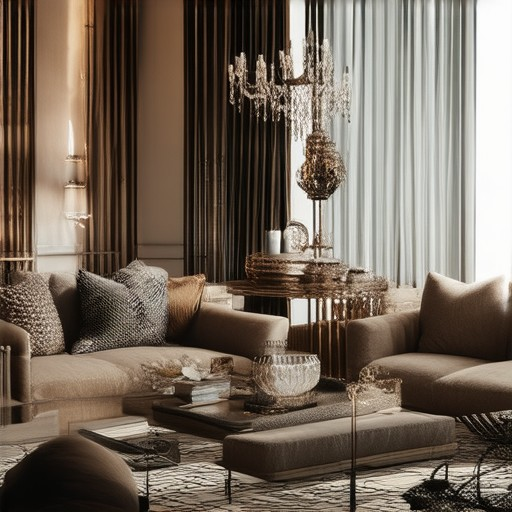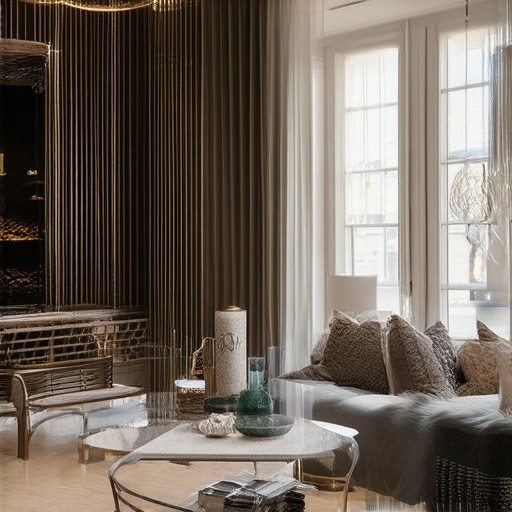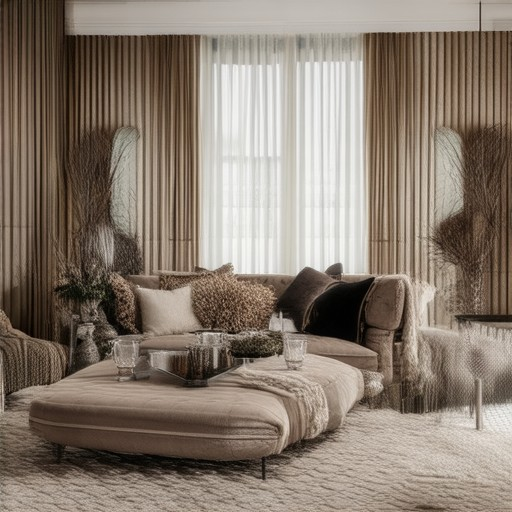Transforming a space through texture adds depth and character, creating a dynamic aesthetic that captivates the senses. While textures are often associated with walls, their application extends far beyond, offering a tactile experience that enhances both functionality and visual appeal. From smooth transitions to bold statements, incorporating textures thoughtfully can elevate a room’s design, influencing mood and ambiance in profound ways. Whether you’re aiming for a minimalist look or a rich, layered environment, understanding how to integrate textures effectively is key to crafting a space that feels uniquely yours. In this guide, we’ll explore the art of decorating with textures, delving into their applications, benefits, and how they can seamlessly blend into your interior design.

What Are the 5 Types of Textures?
We often encounter various textures in our daily lives, each offering unique sensory experiences. Understanding the different types of textures can help us appreciate the diversity of surfaces we interact with. Below, we explore five primary types of textures:
Rough Textures
Rough textures are characterized by irregularities that create a gritty or abrasive feel. Common examples include:
- Sandpaper
- Brick walls
- Cobblestone paths
- Grass
These textures are often associated with strength and durability, making them ideal for certain applications like flooring or construction materials.
Smooth Textures
Smooth textures, on the other hand, offer a uniform or seamless surface that glides easily over the skin. Examples include:
- Glass
- Silk
- Metal
- Plastic
Smooth textures are typically lightweight and elegant, commonly found in items like mirrors, clothing fabrics, and polished surfaces.
Soft Textures
Soft textures are gentle and yielding, providing a comforting sensation. Examples of soft textures include:
- Velvet
- Cotton
- Cloud
- Foam
These textures are known for their ability to absorb impact and are widely used in bedding, upholstery, and padding materials.
Hard Textures
Hard textures are firm and unyielding, offering resistance to pressure. Examples include:
- Stone
- Concrete
- Porous ceramic
- Wood
Hard textures are valued for their durability and are commonly used in structural applications like countertops, floors, and building materials.
Rigid Textures
Rigid textures are neither soft nor flexible, providing a structure that resists deformation. Examples include:
- Plastic
- Acrylic
- Steel
- Resin
These textures are often used in manufacturing and construction for their strength and stability, such as in pipes, beams, and machinery parts.
By understanding and distinguishing between these texture types, we can better appreciate the variety of surfaces in our environment and their respective applications.
How to Use Textures in Interior Design
Textures play a vital role in creating visually appealing and unique interior designs. By thoughtfully incorporating textures, you can transform a space into a dynamic environment that feels inviting and sophisticated. Here’s a guide on how to effectively use textures in your home:
1. Understand the Role of Textures
Textures add depth, interest, and dimension to a room. They can be used to enhance visual appeal, create contrast, and contribute to the overall ambiance of the space. Common textures include materials like wood, stone, metal, fabric, and natural fibers.
2. Incorporate Textures on Different Surfaces
- Walls: Use textured wallpaper, textured paint finishes, or wall panels to add depth. Textured walls can complement decorative accents and artwork.
- Floors: Opt for textured flooring options like hardwood, carpet, or tile. Textured flooring can add warmth and character to a space.
- Ceilings: Consider textured ceiling treatments like coffered ceilings or acoustic panels to add visual interest overhead.
- Furniture: Mix and match textures in your furniture. Combine wood textures with metal accents or leather for a polished look.
3. Create Texture Contrast
Balance is key when working with textures. A monochromatic room with subtle texture variations can feel serene, while a high-contrast space can be dramatic. Pair smooth textures with rough ones, soft with hard, and light with dark for maximum impact.
4. Use Textures to Define Zones
Textiles like rugs, curtains, and throw pillows can zone a space, creating separate areas for different activities. For example, a jute rug can define a dining area, while a silk curtain can frame a sleeping space.
5. Layer Textures Strategically
Layer textures in a room to build depth. Start with a base texture, like a textured wall treatment, and add layers with textiles, art, and decor. Each layer should complement the previous one without overwhelming the space.
6. Consider Texture and Color Coordination
Complementary textures often work best with specific color palettes. For instance, a rough-hewn wooden table pairs well with soft, muted tones, while smooth, polished surfaces can complement cooler hues. Understanding color psychology can enhance the effectiveness of your texture choices.
7. Balance and Proportion
Too much of the same texture can make a room feel flat. Introduce variety by incorporating different textures in smaller quantities. For example, use a bold textile as a feature wall and complement it with subtle textures elsewhere.
8. Think About Application Methods
Know the best ways to apply textures depending on the surface. For walls, consider techniques like spray painting, roller application, or brush strokes. For furniture, techniques like distressing or laminating can add texture depth.
9. Maintain Practical Considerations
Choose textures that suit your lifestyle. High-maintenance textures may not be ideal for busy families, while low-maintenance options are better for those seeking ease of care.
10. Source Inspiration and Resources
Explore design magazines, online platforms, and blogs like Peck and Gartner for innovative texture combinations and application ideas. Their experts provide valuable insights and practical advice to help you create stunning interiors.
By thoughtfully incorporating textures into your interior design, you can create a space that is both stylish and uniquely yours. Experiment with different textures, balance them wisely, and let your personal style shine through!

What Are the 7 Basics of Interior Design?
Here’s a breakdown of the fundamental principles that define modern interior design:
- Functionality :
- Every design begins with purpose. Determine the primary functions of the space, whether it’s for work, relaxation, entertaining, or storage. Ensure that the layout supports these activities effectively.
- Human Factors :
- Consider ergonomics and user comfort. Design elements should align with natural movements and behaviors, promoting productivity and well-being.
- Aesthetics :
- Create visual appeal through color, texture, and pattern. Balance simplicity and complexity to achieve a cohesive look that reflects personal style.
- Color Theory :
- Use color strategically to evoke emotions and create atmosphere. Understand complementary and contrasting colors to enhance the space’s vibe.
- Lighting :
- Lighting is a game-changer. Combine ambient, task, and accent lighting to maximize functionality and ambiance, transforming the space day and night.
- Space Planning :
- Optimize the layout for efficiency and flow. Ensure furniture placement allows for smooth navigation and maximizes usable area.
- Cultural Context :
- Design considers cultural influences and regional preferences, tailoring the space to resonate with the intended audience.
For more insights into creating stunning interiors, explore our interior design resources .

Examples of Decorative Texture
- Natural Textures: Smooth beach stones, rough-hewn wooden beams, fuzzy peach skin, and ribbed seashells.
- Material Textures: Velvet curtains, leather chairs, fur blankets, and metal accents on decorative pieces.
- Creative Textures: Matte finish on walls, high-gloss lacquer on furniture, and textured wallpaper patterns.
- Abstract Textures: Geometric patterns, organic shapes, and asymmetrical designs in textiles and flooring.
For more ideas on incorporating decorative textures into your space, visit our home design blog .
Five Examples of Decorative Items
- Furniture: A decorative vase or an ornate lamp can enhance any room’s aesthetic.
- Lighting: A statement chandelier or a sleek table lamp adds elegance to a space.
- Textiles: Patterned curtains or a colorful throw blanket can tie a room together.
- Wall Decorations: Framed artwork or a decorative mirror can add visual interest.
- Personal Accessories: Stylish jewelry or a vibrant scarf can elevate everyday wear.
These items not only serve functional purposes but also contribute significantly to the overall ambiance and style of a space. Whether it’s through furniture, lighting, textiles, wall decorations, or personal accessories, decorative elements play a crucial role in creating a welcoming and visually appealing environment.
Explore our home decor collection for more inspiration and tips on incorporating decorative elements into your space.

Types of Textures
Material-Based Textures
- Wood: Known for its natural grain and texture, wood can vary from smooth to rough depending on the species and treatment.
- Metal: Can have a smooth, polished texture or a rough, industrial feel, depending on the finish.
- Fabric: Varies widely from soft, silky fabrics like silk to coarse, textured fabrics like denim or corduroy.
- Glass: Typically has a smooth, uniform texture, though some glasses can have etched or frosted textures.
- Ceramic: Often has a matte, earthy texture, but can also be glazed to have a shiny, glossy finish.
- Plastic: Can be smooth and sleek or textured with ridges and grooves, mimicking natural materials.
Surface-Based Textures
- Smooth: Uniform and even, often associated with materials like glass or polished metals.
- Rough: Irregular and uneven, commonly found in natural surfaces like stone or unfinished wood.
- Shiny: Highly reflective, often seen in polished surfaces like chrome or mirrored glass.
- Matte: Non-reflective, giving a dull appearance, typical of certain ceramics or painted surfaces.
- Grainy: Coarse or uneven texture, often seen in materials like sandpaper or certain types of wood.
- Weaved: Created by intersecting threads or fibers, as in fabrics like linen or cotton.
Understanding these texture types can help in selecting materials and finishes that best suit your design needs, whether for furniture, flooring, or decorative elements.
For more tips on incorporating these textures into your home, visit Peck and Gartner .





0 Comments